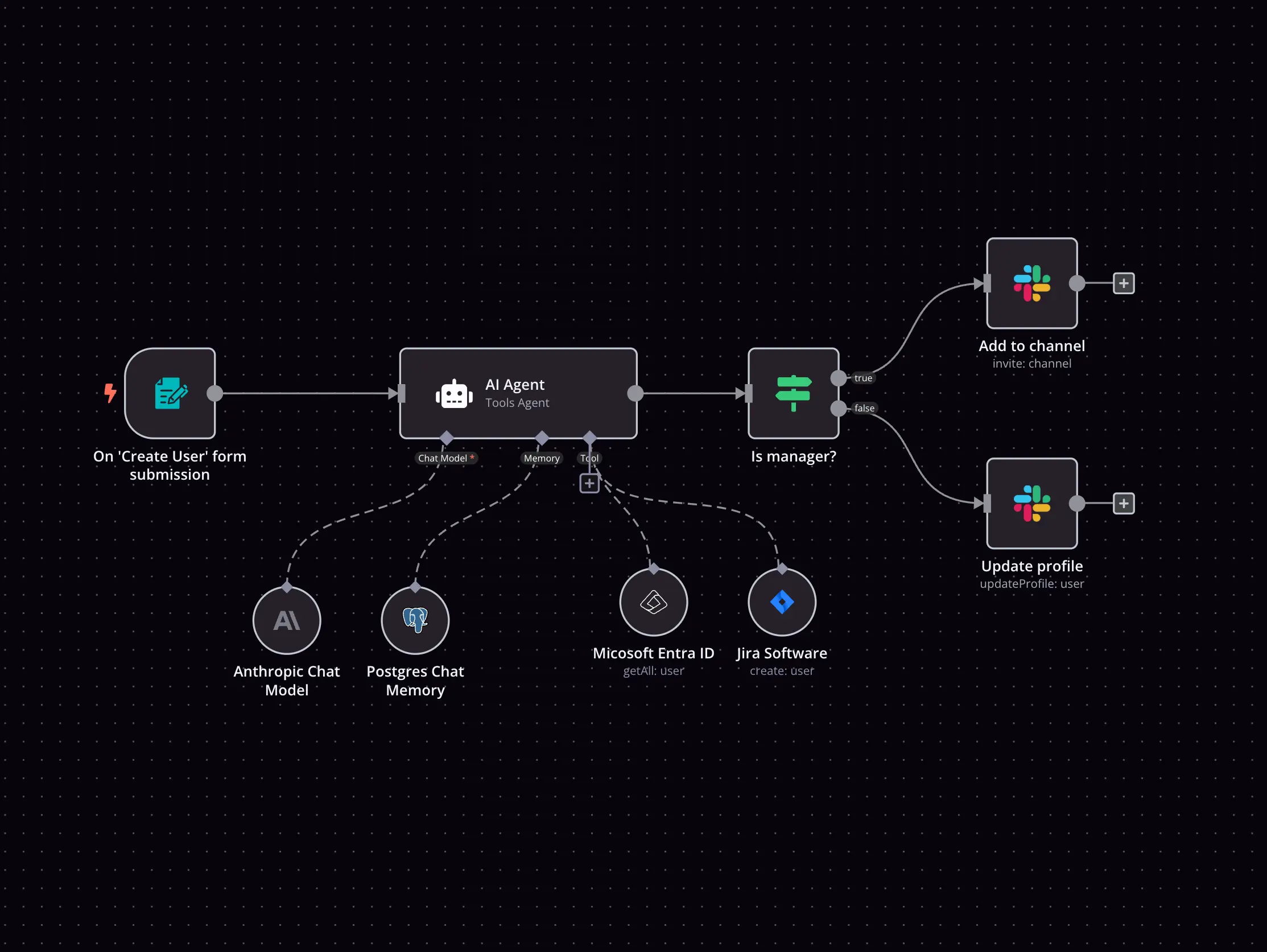Nightfall.ai and Radar integration




How to connect Nightfall.ai and Radar
Create a new workflow and add the first step
In n8n, click the "Add workflow" button in the Workflows tab to create a new workflow. Add the starting point – a trigger on when your workflow should run: an app event, a schedule, a webhook call, another workflow, an AI chat, or a manual trigger. Sometimes, the HTTP Request node might already serve as your starting point.
Build your own Nightfall.ai and Radar integration
Create custom Nightfall.ai and Radar workflows by choosing triggers and actions. Nodes come with global operations and settings, as well as app-specific parameters that can be configured. You can also use the HTTP Request node to query data from any app or service with a REST API.
Supported API Endpoints for Nightfall.ai
Scan Plain Text
Provide a list of arbitrary string data, and scan each item with the provided detectors to uncover sensitive information.
Initiate File Upload
Start the upload process for a file to be scanned.
Upload File Chunk
Upload a chunk of the file being scanned.
Complete File Upload
Complete the upload process for a file that was scanned.
Scan Uploaded File
Scan a file that has been uploaded.
Fetch violations
Retrieve a list of violations identified by the DLP API.
Search violations
Search for violations using specified criteria.
Take an action on Violations
Perform a specified action on identified violations.
Fetch violations
Fetch a list of violations for a period
Fetch violation
Fetch details of a specific violation by ID
Search violations
Search for violations based on specified criteria
Fetch violation findings
Fetch findings associated with a specific violation
Take an action on Violations
Perform specified actions on violations
Fetch violations
Retrieve a list of violations.
Fetch violation
Fetch a violation by ID.
Fetch violation findings
Fetch findings related to a specific violation.
Fetch violation
Retrieve a specific violation by its ID.
Fetch violation findings
Retrieve findings related to a specific violation.
Fetch violations
Get a list of violations.
Fetch violation
Get details for a specific violation.
Search violations
Search for violations based on parameters.
Fetch violation findings
Get findings for a specific violation.
Take an action on Violations
Perform an action on violations.
Fetch violation
Retrieve details for a specific violation by its ID.
Fetch violation findings
Retrieve findings related to a specific violation by its ID.
Fetch annotation
Retrieve details for a specific annotation by its ID.
Annotate finding
Add an annotation to a specific finding by its ID.
Remove finding annotation
Remove an annotation from a specific finding by its ID.
Fetch Github Repositories
Retrieve a list of GitHub repositories.
Fetch Github Repositories
Retrieve a list of connected Github repositories
Fetch Github Repositories
Get a list of Github repositories.
Fetch annotation
Fetch a specific annotation by its ID
Fetch annotation
Fetch an annotation by ID.
Fetch annotation
Retrieve a specific annotation by its ID.
Fetch annotation
Get details for a specific annotation.
Annotate finding
Add an annotation to a specific finding
Remove finding annotation
Remove an annotation from a specific finding
Annotate finding
Add an annotation to a specific finding.
Remove finding annotation
Remove an annotation from a specific finding.
Annotate finding
Add an annotation to a specified finding.
Remove finding annotation
Remove an annotation from a specified finding.
Annotate finding
Add an annotation to a specific finding.
Remove finding annotation
Remove an annotation from a specific finding.
Fetch Github Repositories
Retrieve a list of GitHub repositories.
To set up Nightfall.ai integration, add the HTTP Request node to your workflow canvas and authenticate it using a generic authentication method. The HTTP Request node makes custom API calls to Nightfall.ai to query the data you need using the API endpoint URLs you provide.
These API endpoints were generated using n8n
n8n AI workflow transforms web scraping into an intelligent, AI-powered knowledge extraction system that uses vector embeddings to semantically analyze, chunk, store, and retrieve the most relevant API documentation from web pages. Remember to check the Nightfall.ai official documentation to get a full list of all API endpoints and verify the scraped ones!
Supported API Endpoints for Radar
Track location
Tracks a location update and returns the user and the events generated.
Get context
Gets context for a location based on coordinates.
Forward geocode address
Geocodes an address, converting address to coordinates.
Reverse geocode coordinates
Reverse geocodes a location, converting coordinates to address.
Get geocode by IP address
Geocodes the requester's IP, converting IP address to city, state, and country.
Autocomplete addresses
Autocompletes partial addresses and place names, sorted by relevance and proximity.
Search users
Searches for users near a location, sorted by distance.
Search geofences
Searches for geofences near a location, sorted by distance.
Search places
Searches for places near a location, sorted by distance.
Validate address
Validates the input address.
Calculate distance
Calculates the travel distance and duration between an origin and a destination.
Calculate distance matrix
Calculates the travel distances and durations between multiple origins and destinations for up to 625 routes.
Match route
Snaps points collected along a route to roads that were most likely traveled on.
Get directions
Calculates the most efficient route between two or more locations to visit in order.
Optimize route
Calculates the optimal ordering and route to visit a list of locations.
Create user
This endpoint allows the creation of a new user in the Radar system.
List users
This endpoint retrieves a list of users tracked in your project.
Update user
This endpoint updates the information of an existing user.
Delete user
This endpoint removes a user from the Radar system.
List users
Lists users sorted by updatedAt.
Get user
Gets a user referenced by Radar _id, userId, or deviceId.
Delete user
Deletes a user which can be referenced by Radar _id, userId, or deviceId.
To set up Radar integration, add the HTTP Request node to your workflow canvas and authenticate it using a generic authentication method. The HTTP Request node makes custom API calls to Radar to query the data you need using the API endpoint URLs you provide.
These API endpoints were generated using n8n
n8n AI workflow transforms web scraping into an intelligent, AI-powered knowledge extraction system that uses vector embeddings to semantically analyze, chunk, store, and retrieve the most relevant API documentation from web pages. Remember to check the Radar official documentation to get a full list of all API endpoints and verify the scraped ones!
Nightfall.ai and Radar integration details
FAQ
Can Nightfall.ai connect with Radar?
Can I use Nightfall.ai’s API with n8n?
Can I use Radar’s API with n8n?
Is n8n secure for integrating Nightfall.ai and Radar?
How to get started with Nightfall.ai and Radar integration in n8n.io?
Looking to integrate Nightfall.ai and Radar in your company?
The world's most popular workflow automation platform for technical teams including
Why use n8n to integrate Nightfall.ai with Radar
Build complex workflows, really fast
